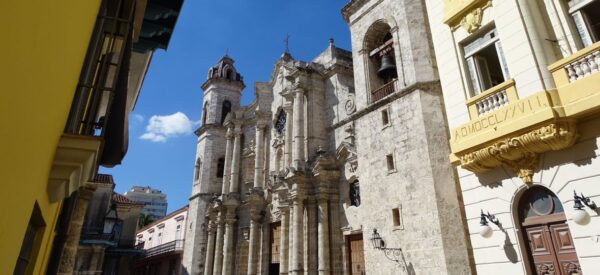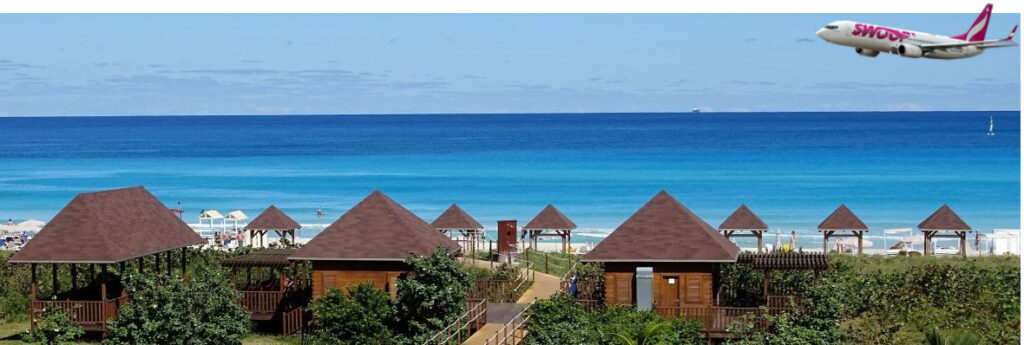With an onboard toast of ceremonial (and symbolic) Gatorade, plus pre-flight goodies for passengers, Swoop launched inaugural no-frills service to Cuba with a full complement of passengers (including Travel Industry Today) headed for sunny Varadero, departing chilly Toronto on W0652.
The flight – welcomed with a fire truck salute upon arrival – represented the “ultra not-expensive” (in Swoop vernacular) carrier’s initial foray to both Varadero and Cuba and also marked the first ultra low-cost flight (ULCC) service from Canada to the island in general.
“We have a beautiful country that’s waiting for you. We’re really excited about today (Jan. 11),” Cuba Tourist Board Canadian director Lessner Gomez declared to passengers during pre-flight remarks.
He added, “Canadians love Cuba and Cuba loves Canadians.”
Gomez said he was already looking forward to more potential Swoop service to his country, noting that discussions for the current Mon.-Wed.-Fri. flights began in 2020, but launch was delayed by the pandemic.
Swoop’s low-cost service will appeal to travellers – including Cuban citizens and expats – who don’t need an all-inclusive package or prefer other accommodation options, such as private homes and Airbnbs, Gomez added.
Flying to Varadero airport also provides easy access to Havana, creating great opportunities for short getaways to the colourful, historic capital after only a three-hour flight.
Air-only prices with Swoop start at $159 one way (bag fees and discretionary buy-on-board options extra).
Julie Pondant of Swoop similarly touted the attractiveness of the airline’s “unbundled” fares for a certain segment of the market, but noted that packages can still be booked.

Departing the same day as Punta Cana flights from Hamilton, Swoop’s entry into Cuba is another step in a whirlwind journey that began when WestJet launched the ULCC in 2018 with only two planes and two destinations. Now, it boasts 16 aircraft and 26 destinations (including 13 from YYZ).
“It’s been really busy, an amazing four-and-a-half years (since launch),” said Swoop marketing exec Kelly Steward, adding, “and there are no signs of slowing down.”
Indeed, on Jan. 1, Swoop registered its single largest travel day, operating 64 flights and carrying 10,268 travellers.
And as for Cuba, Steward declared, “We are confident it will be a success.”
Pondant says adding Cuba to Swoop’s destination roster is an important part of the airline’s growth curve, explaining, “We know it’s an important destination for Canadians and we know the demand is there.”
Flying to Varadero – Cuba’s most popular destination for Canadians – is a natural first step, but also gives access to nearby Havana, she adds.
Further, Swoop’s unbundled model will appeal to non-traditional Cuba travellers, such as students, backpackers, and multi-destination visitors.
“It adds to the (travel) options,” she says
With Swoop, passengers pay a base fare, plus discretionary add-ons – luggage, carry-on (one small personal item like a purse is free), food and drinks, and Internet. (Onboard amenities can be purchased by credit card inflight). Note: Paying for bags in advance is up to 40% less than at check-in).
Packages, as noted, are still available, through WestJet Vacations (with Swoop airfares).
Being part of WestJet is also offers another “huge” advantage for Swoop, which can transfer passengers onto the mainline carrier if necessary in case of delays or cancellations, says Pondant. In Cuba/Varadero, mainline WestJet offer three-times-weekly service on alternate days to Swoop.
With ultimate flexibility and unbundled fares, “what we’re selling,” concludes Pondant, “is that you really have an option to do it another way.”
Cuba report
Lessner, meanwhile, is confident that the entry of Swoop into the Cuban market will help the tourist board’s aim of welcoming one million Canadian visitors in 2023 – a number approaching pre pandemic levels in 2019.
And these visitors will discover, he assures, a new-look Cuba that was not idle during the travel pause, with the opening of both new destinations on the island to visit and new hotels in Havana.
Canadians can also now buy gift cards at banks (up to the equivalent of $5,000 in Cuban pesos) to pay for products and services such as restaurants and shops – “even cigars.”

For those in (or in proximity to) Varadero, a visit to Havana is a must. The lively city can be toured on a day trip (2-1/2 hours by bus). Other options include Jeep tours (including swimming in a cave); drive-your-own jet boat (river) excursions; catamaran outings; and a crocodile farm/Taino village (by boat) attraction on the Zapata peninsula (lunch in the restaurant is exceptional), amongst many more, most of which can be arranged through one’s hotel.
For its part, Varadero – always known for its long stretch of amazing sugar-white sand beach and turquoise water – has come a long way in recent years with a plethora of bars and restaurants, nightclubs, shops, and craft market, many located in the new central “Boulevard” and recently constructed marina district, the latter built for an expected influx of Americans who “never came” (an improving relationship with Cuba during the Obama regime soured again under Trump and the US embargo is still in place).
Internet service is improving and was largely trouble free during our stay at the Melia Internacional, a sparkling new version of the popular property that was rebuilt in 2019 (but was largely unused during the pandemic).
Travel tips
• Canadians can visit Cuba visa-free, subject to filling out a tourist card distributed on the plane. There are no current COVID-10 restrictions.
• Money in Cuba is complicated: Canadian credit cards are accepted (but exchange rates may not be favourable); small bills in Canadian or US are welcome (no coins), especially for tips, and some shops/services accept Cdn. currency. It is recommended to exchange only small amounts into Cuban pesos as they can’t be changed back. (Black market exchanges with more favourable rates are not uncommon but conducted at one’s own discretion).
• Visiting Havana from Varadero is possible and common via inter-city bus (not affiliated with a tour company); hiring a local driver – not least with a vintage car – is another popular option, not just for Havana.
• Russians tourists were still in evidence, but not surprisingly in much reduced numbers, not least because most army-eligible men can’t leave the country. Interestingly, most signage is in English, Spanish, and Russian. Canadians, however, are still the kings of Cuba, and catered to accordingly by locals. (Even carved wooden CFL team beer mugs of all things can be purchased at the Varadero craft market, perhaps making a personal Saskatchewan Roughriders mug the oddest Cuban souvenir you’re ever likely to buy!)
• Recommended local guide: Enrique Casanova, Havana Tours, ecasanova663@gmail.com .

